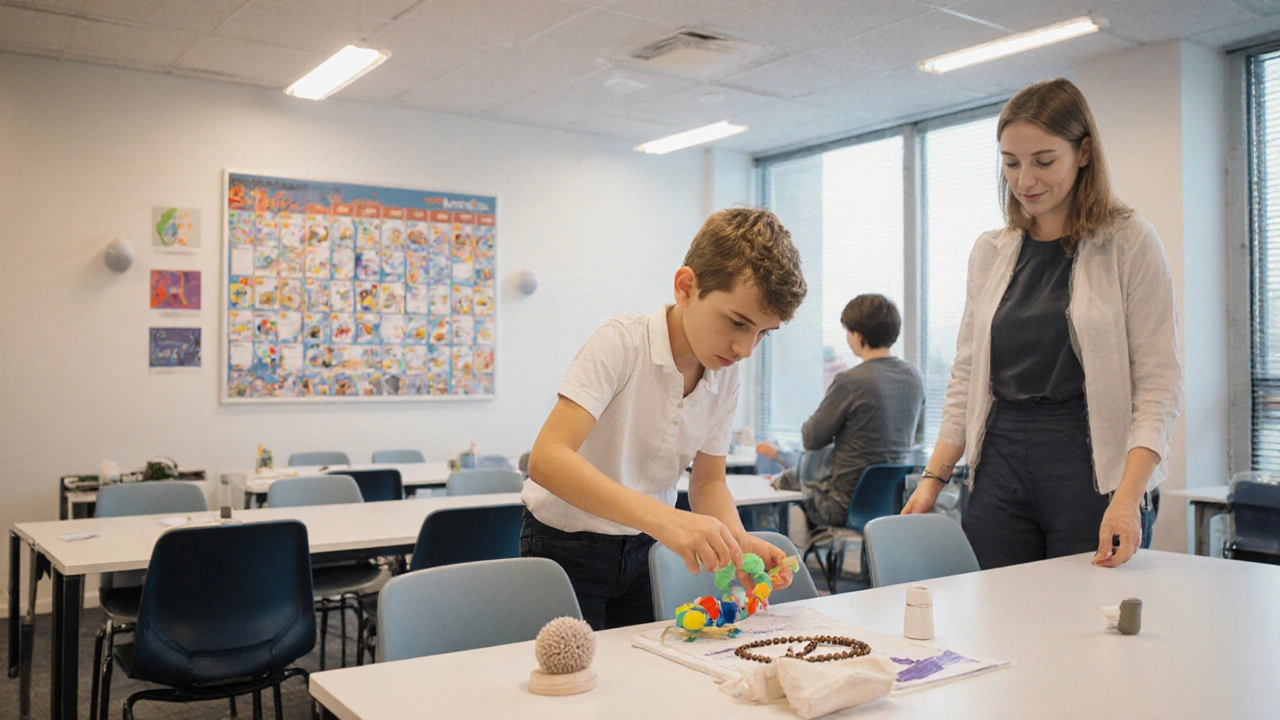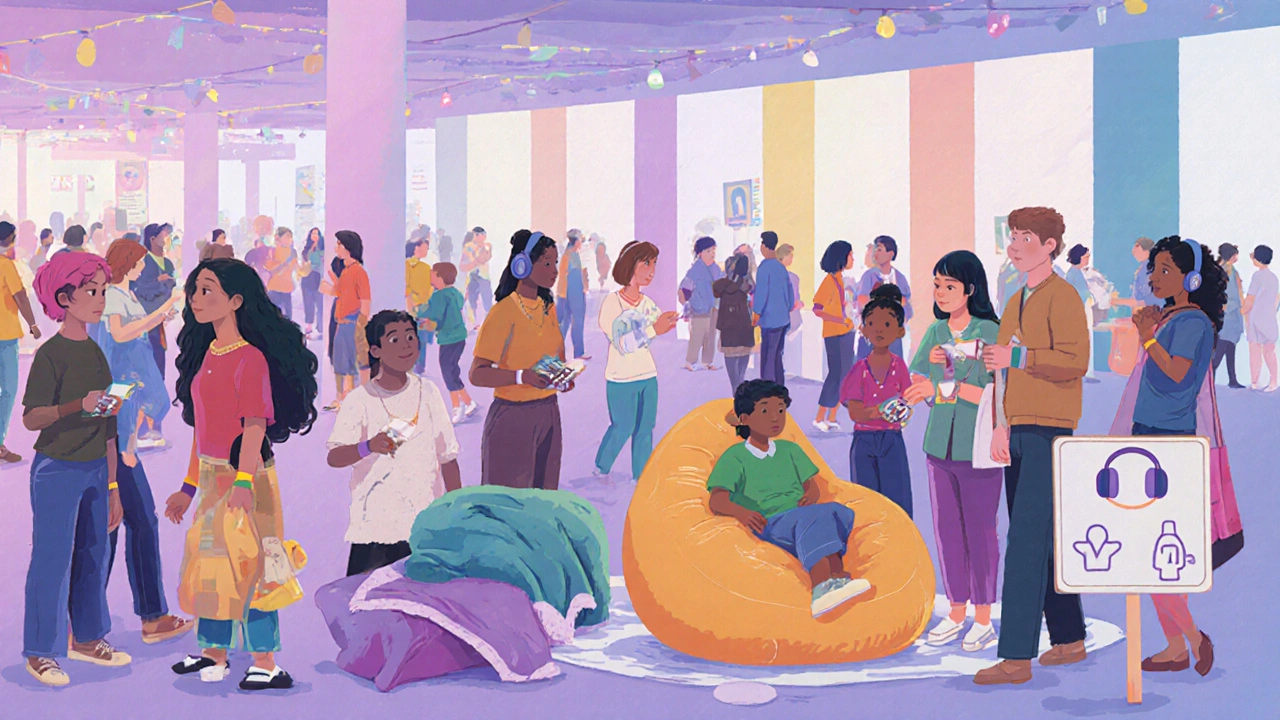Community gatherings are meant to bring people together, but for many on the autism spectrum the noise, lights, and crowds can feel overwhelming. Without thoughtful design, events that look lively to most can become stressful barriers for autistic attendees. This guide shows exactly how to turn a regular venue into an inviting space where everyone, regardless of sensory needs, feels welcome.
Quick Takeaways
- Identify and reduce common sensory triggers such as loud sound, flickering light, and strong scents.
- Provide clear visual schedules and quiet zones before, during, and after the event.
- Train staff and volunteers on neurodiversity basics and how to respond calmly.
- Use simple, affordable tools - noise‑cancelling headphones, soft lighting, tactile fidgets - to create a calm atmosphere.
- Gather feedback from autistic attendees after the event and iterate for next time.
When planning an inclusive gathering, Autism is a neurodevelopmental condition marked by differences in social communication and sensory processing and often requires environments that accommodate heightened sensitivities. Understanding the basics of sensory processing is the first step toward creating truly welcoming community spaces.
Understanding Sensory Processing in Autism
People on the spectrum may experience the world in ways that differ dramatically from neurotypical peers. A sound that seems background chatter to most can be a jarring alarm for an autistic person. Bright, flashing lights might trigger visual overload, while certain textures can cause uncomfortable tactile sensations. These experiences are part of what researchers call sensory processing the way the brain receives and interprets sensory input. When an environment overwhelms the senses, anxiety rises and enjoyment drops.
Because sensory profiles vary widely, the goal isn’t to eliminate every stimulus but to give attendees tools and options to manage their own experience. This mindset aligns with the broader principle of neurodiversity the recognition that neurological differences are natural variations of the human brain, which emphasizes inclusion rather than conformity.
What Makes an Event sensory-friendly events?
A sensory-friendly event an gathering intentionally designed to reduce sensory overload for autistic and other neurodivergent participants incorporates three core elements: environmental adjustments, clear communication, and supportive staffing.
- Environmental adjustments: soft lighting, reduced background music, designated quiet zones, and optional noise‑cancelling headphones.
- Clear communication: visual schedules, signage with symbols, advance program PDFs, and easy‑to‑understand announcements.
- Supportive staffing: volunteers trained in autism awareness, a low‑stress check‑in desk, and a clear escalation plan for sensory emergencies.
When these pillars are in place, the event becomes a community space a public place where people gather for shared activities that welcomes all sensory profiles.
Step‑by‑Step Planning Checklist
- Assess the venue. Walk the space at different times of day. Note sound levels (use a smartphone decibel app), lighting type, and traffic flow. Identify spots that could become quiet zones.
- Consult autistic advocates. Reach out to local autism societies or parent groups. Their insights pinpoint the most common sensory triggers stimuli that can cause discomfort for autistic individuals in that specific venue.
- Choose sensory‑friendly fixtures. Replace harsh fluorescent lights with dimmable LEDs, provide white‑noise machines in quiet rooms, and stock soft‑fabric seating or floor cushions.
- Create visual aids. Design a printable schedule with icons, color‑coded area maps, and clear restroom signs. Offer the schedule online at least one week before the event.
- Set up a quiet zone. Allocate a small room or corner with low lighting, minimal decor, and a supply of fidget toys, weighted blankets, and headphones.
- Train staff and volunteers. Conduct a short workshop covering basics of autism, how to recognize signs of sensory overload, and proper de‑escalation techniques. Provide a cheat‑sheet with key phrases like “Would you like a quieter space?”
- Communicate accommodations. List all sensory options on tickets, event pages, and social media posts. Use straightforward language: “Quiet room available - ask staff for a headset.”
- Gather feedback. After the event, send a brief survey to all attendees, especially those who identified as autistic. Ask what worked, what didn’t, and suggestions for improvement.

Real‑World Examples
Seeing how other organizers have succeeded can spark ideas for your own event.
- City Library Book Fair (Spring 2024) - Added a “Sensory Corner” with soft rugs, low‑volume music, and a curated selection of tactile books. Attendance rose 15% among families with autistic children.
- Downtown Music Festival (Summer 2023) - Offered “volume‑controlled zones” where stage speakers were muted and performances streamed via headphones. The festival earned a local award for accessibility.
- Community Marathon (Fall 2025) - Provided a sensory‑friendly start line with reduced crowd density, timers displayed on large screens, and volunteers wearing bright vests to guide participants.
Common Pitfalls and How to Avoid Them
Even with the best intentions, some details slip through the cracks.
- Assuming one size fits all. Not every autistic person needs the same accommodations. Offer a menu of options rather than a single “quiet room.”
- Over‑crowding the quiet zone. Limit capacity (e.g., 5-6 people) and monitor usage. Too many people defeats the purpose.
- Skipping staff training. Volunteers who are unaware of sensory cues may unintentionally increase anxiety. Even a 30‑minute briefing can make a huge difference.
- Using jargon in signage. Replace words like “sensory overload” with clear actions: “Quiet Area - Ask for a headset.”
- Neglecting post‑event feedback. Without input, you won’t know what to improve. Make surveys short, anonymous, and accessible (both digital and paper versions).
Comparison: Typical Event vs. Sensory‑Friendly Event
| Aspect | Typical Event | Sensory‑Friendly Event |
|---|---|---|
| Lighting | Bright fluorescent, often flashing | Dimmable LEDs, no strobe effects |
| Sound | Live music at max volume, background PA | Reduced background music, optional headphones |
| Communication | Verbal announcements only | Visual schedules, icons, printed agendas |
| Quiet Space | Usually none | Dedicated calm room with sensory tools |
| Staff Training | General hospitality training | Specific autism awareness and de‑escalation |
Next Steps for Organizers
Ready to put the plan into action? Start small. Pick one upcoming event and implement three of the checklist items-perhaps a visual schedule, a quiet corner, and staff training. Measure the impact, collect feedback, and expand from there. Over time, your venue will become known as a welcoming hub for neurodiverse community members.

Frequently Asked Questions
Do I need a huge budget to host a sensory‑friendly event?
Not at all. Many adjustments-soft lighting, clear signage, and volunteer training-cost little or nothing. The biggest investment is time spent consulting autistic advocates and planning ahead.
Can sensory‑friendly practices work for non‑autistic attendees too?
Absolutely. Reduced noise, comfortable lighting, and clear schedules improve the experience for everyone, from seniors to toddlers.
How do I find local autism groups to consult?
Search online for regional Autism Society chapters, check community center bulletin boards, or ask your city’s health department for referrals. Most groups are eager to share best practices.
What if an attendee becomes overwhelmed during the event?
Direct them calmly to the quiet zone, offer a headset or fidget tool, and ask if they'd like a one‑on‑one check‑in. Staff should use a soothing voice and avoid sudden movements.
Should I advertise the sensory‑friendly features publicly?
Yes-clear promotion helps families know the event is inclusive, which can boost attendance and community goodwill. Use simple language and include a brief list of accommodations on your event page.






Chris Meredith
September 28, 2025 AT 09:39Wow, this guide is a game‑changer for community planners! The emphasis on low‑tech solutions like dimmable LEDs and visual schedules is spot‑on. I love hearing the word "neurodiversity" thrown around with real action items. Keep the momentum, folks-let's make every event a sensory‑friendly space.
Jessie Eerens
October 4, 2025 AT 04:32The very notion of inclusivity, when dissected through a phenomenological lens, reveals layers upon layers of hidden bias; each layer, a potential trigger, each trigger, a portal to discomfort. One must ask: why do we persist in constructing environments that cater to the majority, while marginalizing the minority through sheer oversight? The answer lies in systemic inertia, a collective reluctance to re‑engineer the familiar. By integrating soft lighting, auditory dampening, and clear visual guides, we disrupt this inertia; we create a new paradigm where sensory variance is not a flaw but a feature. Consider the auditory landscape: background music at 80 dB may seem innocuous, yet for an autistic individual it can be a cacophonous assault, spiralling anxiety and shutting down cognitive pathways. Similarly, flickering LEDs can induce visual overstimulation, prompting physiological stress responses that manifest as heightened heart rate and muscular tension. The solution? Deploy dimmable, warm‑tone LEDs calibrated to 300 lux, paired with strategic placement of quiet zones that act as sensory sanctuaries. Moreover, staff training must transcend cursory bullet‑points; it should encompass role‑playing scenarios, real‑time de‑escalation drills, and empathy mapping. When volunteers can recognize subtle signs-like fidgeting or avoidance of eye contact-and respond with a calm, authoritative tone, the entire atmosphere shifts from threatening to supportive. Feedback loops are equally critical: post‑event surveys, both digital and paper, must be accessible, anonymized, and succinct, ensuring honest input. Iterative design, fueled by community voices, guarantees continuous improvement. In sum, the architecture of inclusion is built not on grand gestures but on meticulous, data‑driven adjustments that honor every sensory profile.
Caroline Lane
October 9, 2025 AT 23:25Nice guide but i think its overhyped.
Geneva Lyra
October 15, 2025 AT 18:19I really appreciate the cultural sensitivity baked into this checklist. It goes beyond mere logistics and acknowledges the lived experiences of autistic folks from diverse backgrounds. Adding multilingual signage and community liaison roles can bridge gaps that even the best‑crafted schedule might miss. Keep shining this inclusive light!
Moritz Bender
October 21, 2025 AT 13:12Here are a few practical pointers you can start using today: • Deploy inexpensive noise‑cancelling headphones – you can bulk‑order them for under $15 each. • Set up a "Calm Corner" with weighted blankets, fidget spinners, and soft‑play mats. • Use a simple QR‑code on the flyer that links to a PDF of the visual schedule. 📌 Remember, the ROI on accessibility is massive – you’ll see higher attendance and better community goodwill. 😃
Nicole Hernandez
October 27, 2025 AT 07:05Thank you for the detailed suggestions; they align well with best practices in event design. Incorporating a QR‑code for the schedule not only modernizes the experience but also reduces paper waste, which is an added sustainability benefit. I would also recommend a brief pre‑event walkthrough for volunteers to familiarize them with the calm corner layout. This hands‑on exposure can boost confidence and response speed during the actual event.
florence tobiag
November 2, 2025 AT 01:59While the advice sounds polished, have you considered that many venues secretly monitor attendees with hidden cameras?; the so‑called "quiet zones" could become surveillance traps, feeding data to corporate analytics firms; this undermines any claim of genuine inclusion!; One must question who truly benefits from these superficial adjustments.
Terry Washington
November 7, 2025 AT 20:52Honestly, this whole "sensory‑friendly" trend feels like performative activism. Organizers slap a few dim lights onto a venue and pat themselves on the back, yet they ignore deeper systemic barriers – transportation, economic access, and the very fact that many autistic adults are still marginalized in society. If you truly want change, start by allocating real budget, not just free headphones.
Claire Smith
November 13, 2025 AT 15:45The critique raises valid concerns; however, the guide does address budget considerations, noting that many adaptations are low‑cost. While it may not solve all systemic issues, it provides a tangible starting point for event planners.
Émilie Maurice
November 19, 2025 AT 10:39That statement is overly vague. The guide clearly lists inexpensive tools (LEDs, headphones) that can be bought for under $20. It's not a blanket solution, but it's accurate and actionable. Stop oversimplifying.
Jimmy Gammell
November 25, 2025 AT 05:32Great job putting this together! 👍 As a coach, I always tell my teams that preparation is half the battle. Start small – pick one event, implement three of these tips, and watch the difference. If you need a hand setting up the quiet zone, just holler. 😊
fred warner
December 1, 2025 AT 00:25Exactly! A step‑by‑step approach keeps things manageable and avoids overwhelm. Plus, when you see attendees relaxing in the calm corner, the payoff is immediate. Keep the momentum going!
Veronica Mayfair
December 6, 2025 AT 19:19✨ Love the energy! Adding some colorful posters with emojis can make the visual schedule even more inviting. 🎉 It’s the little details that make a big impact.
Rahul Kr
December 12, 2025 AT 14:12Interesting read. I think the checklist is solid, but many small venues might find it hard to allocate space for a quiet zone.
Anthony Coppedge
December 18, 2025 AT 09:05Indeed, spatial constraints are a common hurdle; however, creative solutions exist, such as using portable partitions or designating a corner of a larger room as a low‑stimulus area. Additionally, scheduling staggered entry times can reduce crowd density, thereby mitigating sensory overload without requiring extra square footage.
Joshua Logronio
December 24, 2025 AT 03:59Just a heads‑up: some big tech companies are inserting hidden sensors in public venues to track foot traffic. If you’re not careful, you might be handing over data about autistic attendees without their consent. Stay vigilant!